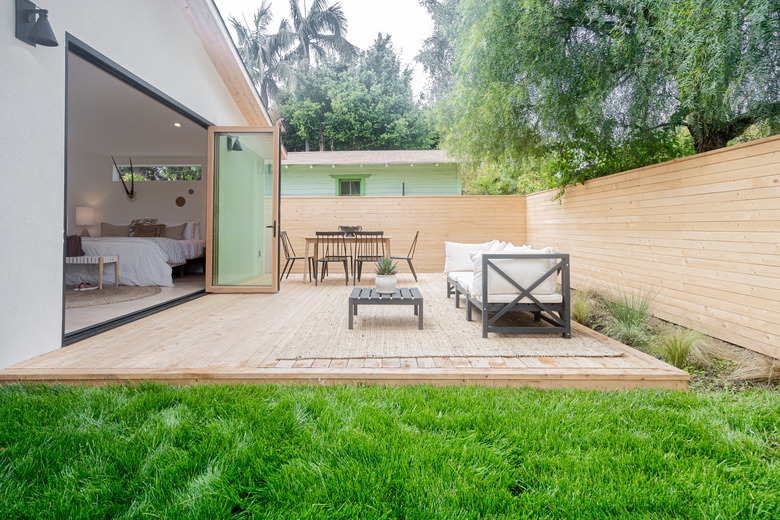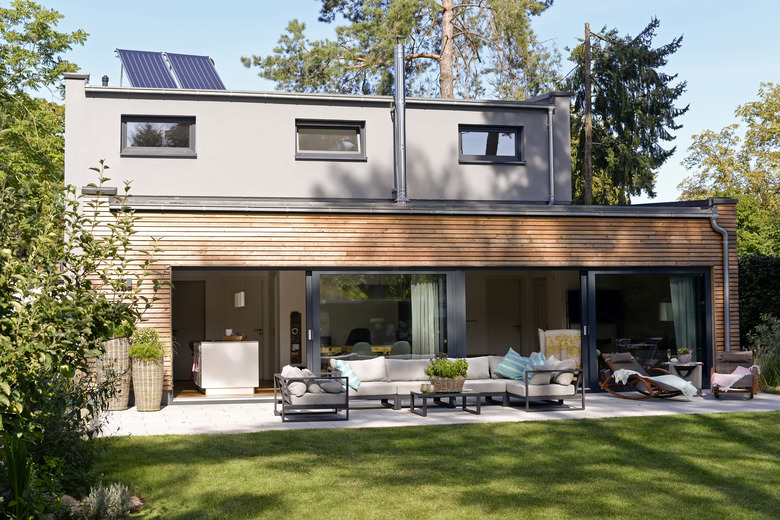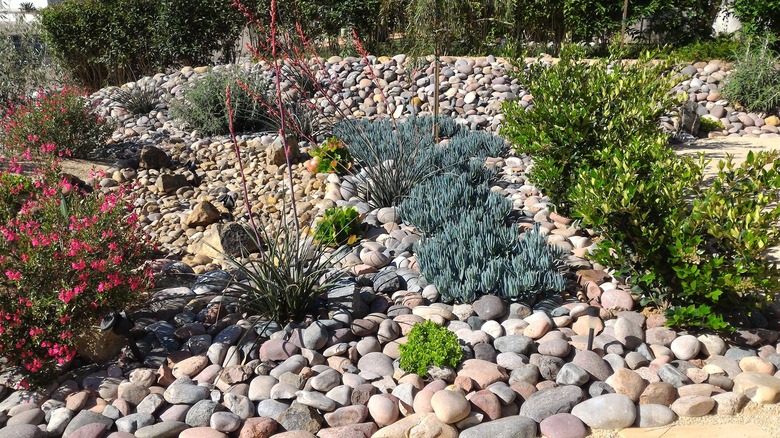Common Types Of Yard Drainage Systems
Every property owner has to consider landscape drainage and decide which of the many available drainage systems best suits the property. If left to flow on its own, rainwater can render part of the landscape devoid of vegetation, undermine the house's foundation, cause damaging erosion or all three.
Drainage systems aren't complicated, but building one involves digging, grading and hauling, and depending on the amount of earthmoving involved, it often requires heavy equipment. According to data from the Landscaping Network, costs can range from 50 cents per square foot for a swale to $70 per linear foot for a full-on trench drain to protect the driveway. Costs are influenced by soil type and accessibility for heavy equipment as well as the need to demolish existing and outdated drainage systems and to haul dirt off-site, so budget may be a factor in choosing the ideal drainage system for your property.
Designing Drainage Systems
Solutions to drainage problems rely primarily on gravity; water flows downhill, and it always follows the path of least resistance. Most properties are sloped to some degree, and the goal is to alter the natural water drainage pattern to keep water away from building foundations (where it can cause structural damage) and prevent it from forming bogs in low-lying areas with poorly draining soil. An important principle is to avoid sending the water onto a neighboring property, and Easy Digging recommends directing it to a street or a well-draining location on your own property if at all possible.
The design of drain systems starts with observing the natural flow of water and staking out problem areas. You may notice a large amount of surface water near a building downspout caused by unusually heavy flow or dense soil, and the water could be flowing back toward the foundation, creating a boggy mess and threatening the structural integrity of the building. Your property may also be host to a veritable lake or river formed during seasonal heavy rainfall. Once you've identified each problem area, you can make a map to help you plan the best strategy. Choose from the many common drainage solutions available, each of which has its own pros and cons.
The Cost-Effective Grassy Swale
A swale is a ditch that is about three times as wide as it is deep, and because building one involves little more than moving earth, it's one of the least expensive drainage solutions available. A swale can direct stormwater to a runoff point, but as the Permaculture Research Institute advises, you can also build a "swale on contour," or contour swale, to keep the water stationary so it can seep into the ground. A swale on contour makes an especially fertile planting area, and in fact, it has to be planted with grass, shrubs and trees to prevent erosion.
What to like: Installing a swale is easy enough to be a DIY project, although you'll need heavy equipment to build a large one. A swale requires no materials other than sod or new plantings, and it adds character to the landscape.
What not to like: If runoff from rainfall is insufficient to keep the soil moist and the plants growing, a swale can quickly devolve into nothing more than a large trench, but it is possible to prevent this by using drought-tolerant plants. Without plant roots to hold the soil together, a poorly vegetated swale will quickly erode when a rainstorm does occur.
French Drains: Popular Drainage Solutions
Named after the man who invented them (not the country), French drains are underground pipe systems designed to soak up surface drainage water and direct it to a runoff point, which is either land that slopes safely away from the house and neighboring properties or to a catchment area, such as a dry well. Most French drains consist of perforated drain pipe laid on a bed of drainage rock, covered with filter fabric to prevent clogging and buried under 4 or more inches of soil.
One of the more important uses of a French drain is to catch excess water from gutter systems and direct it away from building foundations. French drains are also effective for draining water from low-lying areas in the yard and for draining driveways.
What to like: Although installing a French drain does involve digging and hauling gravel, it can be a DIY project, especially if you rent a trencher to do the digging. Once in the ground, a French drain is invisible and has no visual impact on the landscape. When it is properly installed, it can last for decades.
What not to like: The biggest drawback of French drain systems is that they clog. Filter fabric forestalls this to a great degree, but it can't keep out roots from nearby shrubs and trees. Once a French drain system clogs, it won't do its job, and the only remedy is to dig it up and start over.
Central Drainage With a Dry Well
Often used in conjunction with a French drain or a swale, a dry well is basically a catch basin for excess water. You dig a hole in the ground, line it with filter fabric, fill it with gravel and top it off with a layer of topsoil and sod. Water flows into the well (either directly or from a French drain or swale) and slowly percolates into the ground and returns to the water table. A typical dry well is about 4 feet in diameter and 3 feet deep, but it can be any size you want. Some landscapers dig a small dry well next to each downspout to control the runoff from just that downspout.
What to like: Another DIY project, a small dry well can be dug with nothing more than a post-hole digger, but it will take an excavator to dig a larger one for stormwater management. Because a dry well allows water to seep back into the earth and the groundwater, it's as much a water conservation tool as it is a drainage system.
What not to like: When installing a dry well, it's important to dig it deep and wide enough to hold all the water it has to manage. Otherwise, the well will overflow and defeat the purpose of digging it in the first place. Another problem is that like a French drain, a dry well can clog, and the only way to unclog it is to dig it up.
A Dry Creek for Arid Locations
A dry creek bed is a trench covered with decorative rocks and stones that provides a drainage path for heavy runoff. Used primarily in arid or semiarid locations that experience the occasional heavy rainstorm, it's designed to be as decorative as it is functional, and some people choose to build one simply to add character to the landscape. In areas prone to washouts, retaining walls can be used to control flow through the creek bed.
What to like: Installing a dry creek is simple, involving little more than marking the outlines of the creek bed, digging it out, installing stones — which are usually river rocks of various sizes — and using mortar to prevent them from separating when water runs through the bed. In areas with sufficient moisture and shade, moss can be incorporated in the design to complement an Asian or English garden motif.
What not to like: Of all the drainage solutions, a dry creek has the most visual impact, so care must be taken in the design and installation. If smooth rocks are used without sufficient anchoring, they can wash away and end up littering the yard.


